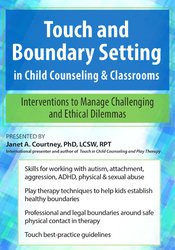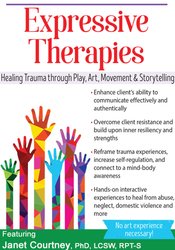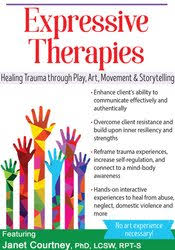🎁 Exclusive Discount Just for You!
Today only: Get 30% OFF this course. Use code MYDEAL30 at checkout. Don’t miss out!
As practitioners, we and Every day, educators are confronted with ethical dilemmas. and clinical/ educational dilemmas related to touch from a child’s request for a hug, to a child inappropriately touching, to physical acts of aggression.
Janet Courtney – Touch and Boundary Setting in Child Counseling & Classrooms

How to break down the Touch Controversy
- Why the problem with touch & children?
- Touch Children vs. adults
- “No touch” policies—More harm than good?
- Touch and Your code of ethics
- Male vs female practitioner liability
- Examining the “slippery slope” Argument
- Current research
Neurobiology Touch
- Oxytocin—the “calming & connectivity” hormone
- Cortisol & hurtful or stressful touch
- Parasympathetic nervous System (PNS).
- C-tactile fibers—Emotional touch
- Sensory mirror neurons: Develop empathy and Interconnectivity
- Psychoeducation
Assessment of Mediating Factors Touch
- Types: Practitioner initiated, child initiated, task-oriented, referential…
- Child’s age, gender, diagnosis
- Theoretical approach
- Cultural, religion, and more…
Case Examples/Ethical Dilemmas – Respond, Intervene & Set Safe Boundaries in Clinics/Classrooms
- Recommendations for working with physically & sexually abused children—attunement/ proximity/cues
- Alternatives to physical restraint for physically aggressive teens/children
- Skills for working with children diagnosed with autism, reactive attachment disorder, ADHD (attunement/proximity/cues)
- Child Restraint—informed consent sample
- Handling inappropriate touching by children
- Developmental differences: infants, children, teens
Play Therapy & Assessments – Touch As an Intervention
- Developmental play therapy—touch and attachment disorders
- DIR/floortime and Autism in children
- FirstPlay®–facilitating corrective (and Infants can have preventive (or therapeutic) contact experiences between them and Parents
- Touch in Animal assisted therapy
- Peer-To-peer massage in schools
- Touch in groups: dance & movement/bereavement/play therapy
- Exemples of Cases
Lab Experiential—Growing Professional Self-Awareness
- Knowing your own proximity space boundaries & comfort
- Side hugs & acceptable touch alternatives
- Establish appropriate boundaries for children
- Small group discussion on professional touch survey
- Practice boundary setting interventions—through mock demonstrations
Make yourself a success! “Touch Educator” With Creative Play-Basal Interventions
- “Captain May I”
- ‘Red Light, Green Light’
- Personal Space Hula Hoop
- “My No Touch Square!” chant activity
- Creating safe boundaries in the sandtray & clay
- Use case studies as a guide to your practice
Growing Ethical Competency in Touch
- Aristotle’s “Practical Wisdom”
- 5 core competencies in touch
- Clinical & ethical touch guidelines
- Liability risk management— informed consent
Would you like to be contacted? Janet Courtney – Touch and Boundary Setting in Child Counseling & Classrooms ?
Description:
- Skills for working with autism, attachment, aggression, ADHD, physical & sexual abuse
- To help children establish healthy boundaries, play therapy techniques can be used
- Professonal and Legal boundaries regarding safe physical contact in Therapy
- Touch best-Guidelines for practice
Touch in Therapy with children is a taboo subject for a long time and A hotbed of controversy
As practitioners, we and Every day, educators are confronted with ethical dilemmas. and clinical/ educational dilemmas related to touch from a child’s request for a hug, to a child inappropriately touching, to physical acts of aggression.
Join Janet Courtney, PhD. LCSW. RPT. and Leading expert in The field of touch in This is the ground-breaking workshop. Learn the latest research on the neurobiology and touch. and attachment, plus the varied mediating factors that impact child initiated verses practitioner/educator initiated touch.
Explore a variety of touch-Informed play therapy is an ethical intervention that addresses child problems and Diagnoses related to trauma, sexual and Domestic violence, physical abuse, ADHD, anxiety and attachment.
You’ll walk away with new interventions to successfully manage in-The-Momentary challenging touch behaviors as well as play therapy-Based techniques to aid children and Teens establish healthy boundaries of touch. Your professional awareness should be increased and Competency through laboratory activities and Clinical and To immediately reduce the risk of liability, follow these guidelines.
Course Features
- Lectures 0
- Quizzes 0
- Duration Lifetime access
- Skill level All levels
- Language English
- Students 82
- Assessments Yes


